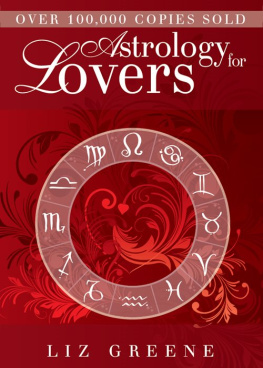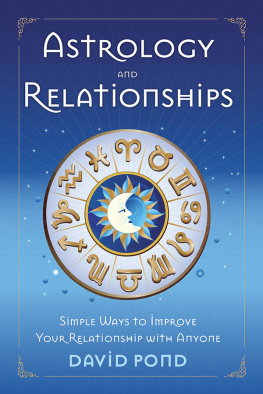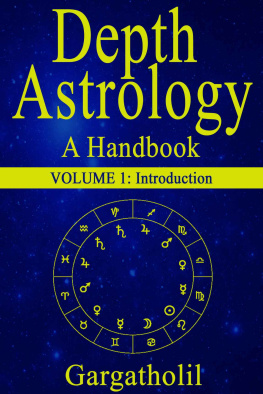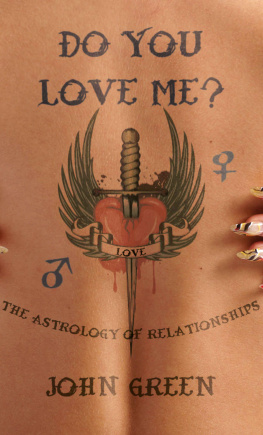CPA Seminar Series
Relationships
and
How to Survive Them
Liz Greene
CPA
Centre for Psychological Astrology Press
London
First published 1999 by The Centre for Psychological Astrology Press, BCM Box 1815, London WC1 3XX, GB
This Kindle Edition published 2013 by CPA Press
RELATIONSHIPS AND HOW TO SURVIVE THEM
Copyright 1999 by Liz Greene
Liz Greene asserts the moral right to be identified as the author of this work.
All rights reserved. No part of this book may be reproduced or transmitted in any form or by any means, electronic or mechanical, including photocopying, recording, or by any information storage and retrieval system, without permission in writing from the publisher.
Table of Contents
Part One: The Composite Chart
This seminar was given on 27 April 1997 at Regents College, London as part of the Summer Term of the seminar programme of the Centre for Psychological Astrology.
The meaning of the composite chart
Technical matters
I am assuming all of you here today know what a composite chart is. But it might be helpful to mention some basics, just in case someone is lurking behind a chair who isnt familiar with this astrological approach to exploring relationships . A composite chart is based on the midpoints between two birth charts. Although each individual in a relationship has his or her own independent identity, when we look at the composite chart we are viewing a third entity, different from either of the two individuals, which needs to be considered along with the more traditional synastry between the two charts. This third entity has its own psychological dynamics and its own mode of expression. The composite chart may not look a lot like either of the charts of the two individuals, and may contain configurations which do not appear in the natal charts. The composite chart has a distinct nature of its own.
Before we explore what the composite chart might tell us about a relationship, I should point out that working with composites may involve a number of different techniques. For example, it is useful to look at the progressed composite during a critical time in a relationship, so we should know how to calculate this. It is also useful to compare the composite with the charts of the two individuals, using basic synastry techniques, and also to look at how the progressed composite affects the two people and how the progressed charts of the two people affect the composite. Most computer programmes will calculate a composite chart, but we should still understand how to work one out by hand, as it were, so that we have a real sense of what we are dealing with.
If we are going to set up a composite chart without a computer, we must work out the midpoints or half-sums between each pair of identical planets in the two birth charts. We take the degree and minute of the Sun of one person and the degree and minute of the Sun of the other, and we find the midpoint between them; that gives us the composite Sun. We take the degree and minute of the Moon of one person and the degree and minute of the Moon of the other; the midpoint between them gives us the composite Moon. And so on. That is simple enough.
There are always two midpoints for any pair of planets a near one and a far one, depending on whether we measure the distance between the planets in the direction of the order of the zodiacal signs, or in the opposite direction. The two midpoints between any pair of planets are always exactly opposite each other. If one persons Sun is in 5 Cancer, and the others Sun is in 5 Virgo, the near midpoint will be 5 Leo, the half-sum of the distance of 60 between the two Suns measured by moving in the natural order of the signs. The far midpoint will be 5 Aquarius, the half-sum of the distance of 300 between the two Suns measured by moving in the opposite direction around the zodiac circle. The midpoint usually used in the composite chart is the near one, although there may be times when this has to be adjusted. We will deal with this issue later.
With the house cusps and the Ascendant, there seems to be some argument amongst astrologers. I dont really understand why this should be. If we are going to do a midpoint chart, then we do the whole thing as a midpoint chart, and this includes the midpoint between the two Ascendants, the midpoint between the two MCs, and the midpoints between every other pair of house cusps. For reasons which I can only attribute to the creative fertility of the human mind, the idea has arisen in some quarters that we should find the composite MC by taking the midpoint between the two natal MCs, and then look in a Table of Houses to find the Ascendant for the latitude and longitude where the two people are living.
Now, that sounds very interesting. But what is the logic behind it? People in relationship do not always live together. Also, it is possible to do a composite between oneself and someone who has been dead for six hundred years. What longitude and latitude do we use then? The location of the remains? More importantly, in practise, when I have looked at the repercussions of important transits moving across the composite Ascendant, it is the midpoint Ascendant that seems to be operative, not the one based on the longitude and latitude of the couples domicile if there is a domicile to begin with.
Having drawn up a composite chart with either a computer or our own mathematical skills, we may occasionally find some astronomical anomalies. Using the near midpoint, we may find Mercury or the Sun opposite Venus. Some astrologers correct these so that they make astronomical sense. But I feel we should leave such anomalies alone if possible, because this is not the birth chart of a human being. It is a mathematical abstraction. The Sun opposite Venus in a composite chart will tell us something important about the relationship. It may be impossible astronomically, but a composite is not a map of the heavens. It has nothing to do with where the planets are actually placed.
Occasionally we will get other anomalies. If two people have the Sun in exactly the same degree and minute of opposite signs, there is no near midpoint. This is obviously not a common occurrence. But if one person has the Sun in 3 24 Aries, and the other person has the Sun in 3 24 Libra, the composite Sun could be placed in either 3 24 Cancer or 3 24 Capricorn; and which midpoint do we then use? When this happens with any composite planet, it is helpful to look at the houses in which the planet is placed in the two birth charts, and try to place it in the quadrant of the composite chart which seems to reflect this most accurately.
One plus one equals three
The concept behind the composite chart or, as Erin Sullivan sometimes calls it, the compost chart is that it represents the relationship itself as a third factor. Two people create a third thing between them. The composite chart is like an energy field, which affects both people and draws certain things out of each individual as well as imposing its own dynamics on both. The composite doesnt seem to describe what either person feels about the other. In this way it is very different from synastry, which describes the chemistry between two people in terms of how they affect each other. When we are exploring the synastry in a relationship, we say, Your Venus is on my Mars. You are activating my Mars and bringing a Mars response out of me, and I am activating your Venus and invoking a Venus response in you. Consequently we feel a certain way about each other. When we are looking at a composite chart, we are not exploring what two people activate in each other or feel about each other. We are interpreting the energy field they generate between them. The composite chart is like a child, a third entity which carries the genetic imprints of both parents but combines these imprints in an entirely new way and exists independently of either of them.













